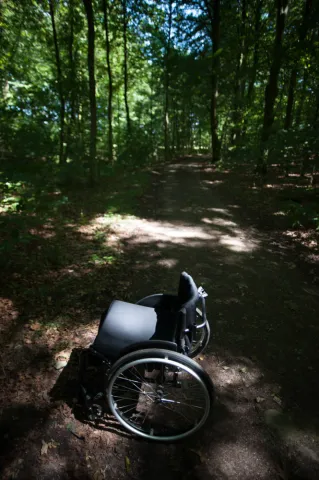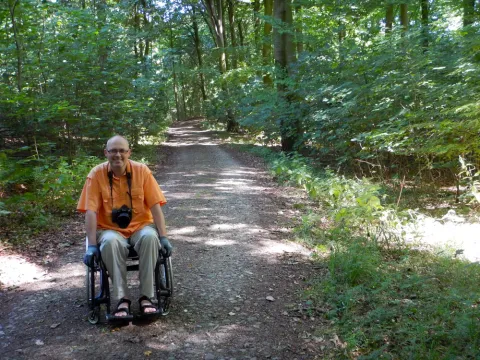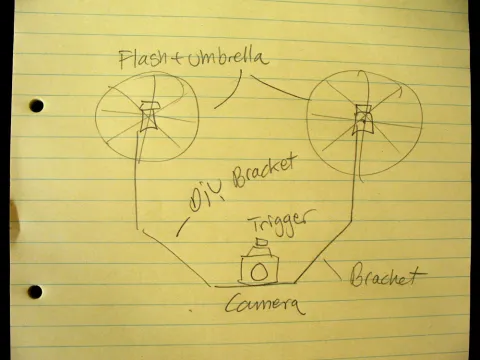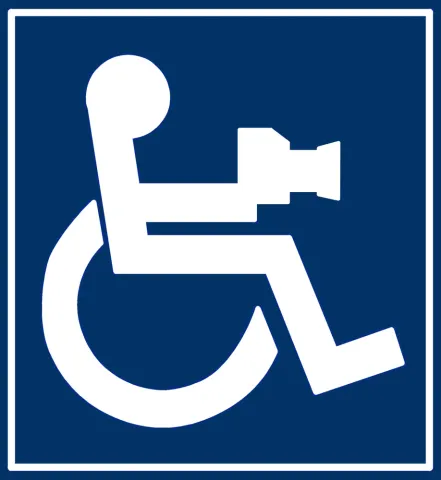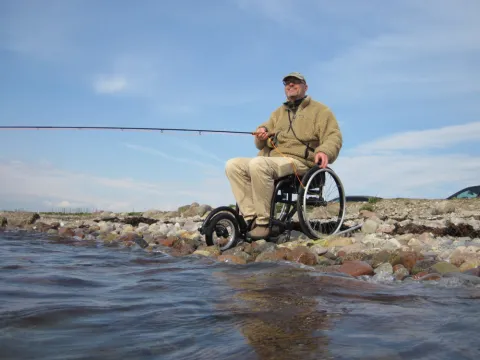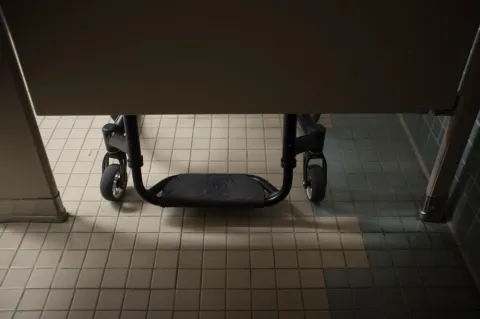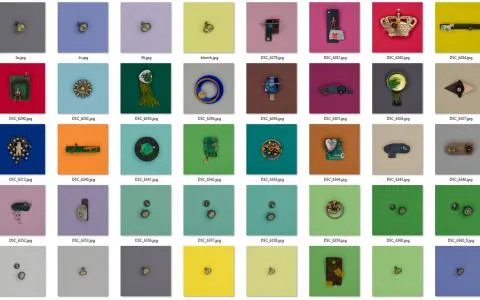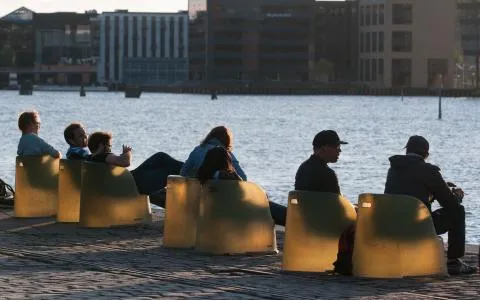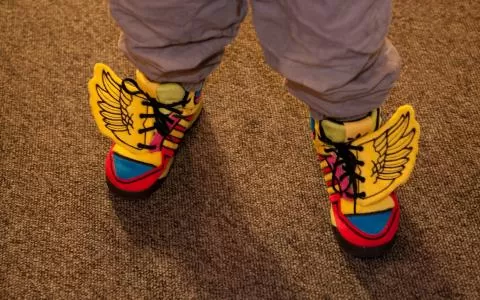No, I don't mean a someone who takes pictures of wheelchairs or of people in wheelchairs, but a photographer sitting in a wheelchair. That's what I am.
Some years ago I started developing a strange numbness in my legs, an odd imbalance and fatigue, and when doing outdoors on location shoots I often became so tired that I had to sit down and take a break several times during a day. At the end of an active day I could barely stand.
There was a reason. After having totally lost control with one leg, I was diagnosed with MS (Multiple Sclerosis) and over a period of a few years I lost almost all feeling in the legs, a lot of range when walking, had to use a cane and then a walker, had a hard time keeping balance and finally wound up in a wheelchair. Luckily the disease is not developing as rapidly now, but I still need a wheelchair for going stretches longer than a fifty to a hundred meters.
That did of course influence my life quite severely. I was an avid fly-fisherman and a large part of my photography was done while being outdoors and fishing. I regularly sold images to magazines and newspapers, and also shot images for articles that I wrote for Danish and international fishing magazines and books as well as my own fly-fishing web site. In that period I also did a weekly podcast for the online community The Nikonians as well as a podcast on fly-fishing for my fishing site, and had many other activities based on being outdoors and moving around.
That did of course influence my life quite severely
An odd mix
I know this article might seem to be an odd mix to some: part about MS and its severe miseries and part about minor pieces of photographic equipment that I have acquired or constructed to make my photographic life easier. But I wanted to tell you the background, but at the same time keep things on a practical level, which might help others who are in a situation similar to mine.
I was wasted
As my health got worse I lost the energy and drive to continue fishing, walking, taking pictures, recording and producing - and a lot of other things, actually.
My ability to move around was more and more limited and my mental and physical energy would quickly deplete if I was active for a longer time – like an hour or two in the beginning down to half an hour when it was worst.
When I was fishing I wasn't able to walk on rocky beaches anymore, and wading in the water became more and more tiresome and stressful. I couldn't hold my balance in the water without a staff to support me, and carrying a large SLR camera while fishing as I had always done, became too risky since I did stumble now and then.
Scouting locations, setting up and executing photo sessions also became too much. On one of my last Nikonians shoots I had two models posing, was setting up lights and running around finding angles and directing the models, and I remember at one point when they were changing, I simply had to sit down on the floor and rest, which had never happened before.
I was wasted!
Looking back on my archives I can see on the number of images I shot that I really took a dive in my photo activities and shot less than I had done for years.
In 2008 I shot more than 35,000 images. In 2009 that dropped to 11,000 and I haven't shot over 10,000 images any year since then.
But I kept on shooting. I always loved taking pictures and even though I don't get out as much as I used to – or as much as I want – I shoot indoors, in my local neighborhood and bring a camera everywhere and still enjoy taking pictures as often as the opportunity is there.
Now several years have passed and I'm coming to terms with the fact that I'm chronically and severely ill, I'm adapting to the new reality.
So ... what's it like to have MS?
There's no simple answer to that question other than "It sucks!". And that's putting it very mildly.
The disease is very different from patient to patient, and while some are only superficially affected, others are hit to an extent where they would rather be dead - literally. My version of MS is called secondary progressive, meaning that it worsens at a varying pace unlike the most common type relapsing-remitting MS where the disease develops in attacks, each time making the patient worse, but with possible partly recuperation in between. There's no cure for either, but means to keep attacks low. People with relapsing MS can develop secondary progressive MS. Unfortunately there's really very little to do against the progressive versions.
A simple question
I recently read a very interesting post on an MS blog, which might put the varying severity of MS into perspective.
A simple question: Imagine that your MS could be cured, but the cure would kill you after X months. What's your X?
The replies were down to a few months and even weeks. People would die for a shockingly short time without their disease, being able to walk, dance, make love, control their bowels, sink food, see, be free of pain. That's how bad it can be!
In my own case I would not risk my life for a cure.
Heck, it can be a pain to get out of bed! It's frustrating not to be able to feel my feet. It sucks to be unable to control my bladder, and being unable to tolerate just moderately warm days simply stinks. Every day activities like cooking a meal requires me to sit down several times underway. It's also a heavy mental burden to know that new body parts can start failing and hurting any day: hands, arms, eyes, throat, you name it. The results of really severe MS are not pretty to say the least.
But as I am right now, I can drag myself onto my feet when I fall and I do get out of bed by myself every day. My brain functions, I can see, I can eat and drink, I can concentrate, I can work for a living.
I can cope.
When the hospital asks during my regular checkups how I'm doing, I can sincerely say that I'm doing fine.
It could be better, but realistically it is as good as it gets under these circumstances. I have my family and friends, my good mood and a reasonable control over my decaying body.
I'm doing fine.
PS: My apologies to other MS patients for this simplified and self-centered explanation. I know a lot of you are much, much worse off than I am, but I decided to explain this from my personal standpoint. That is after all what I know best ...
Chronically ill
The thing about being chronically ill is that it's chronic. As in permanent, incurable, not going away. My wheelchair is here to stay, as is my fatigue, my imbalance and the many other miseries that come from MS. I'm not waiting on a magic recovery or a miracle medicine. I might get better, but I'm honestly not planning my life on that hope. Reality is a lot harsher, and MS is not a kind malady. So I have decided to adapt and cope and to try to get the best from my situation, realizing that I can do very little to keep things from going as they might.
Much of my photography now takes place indoors. I don't plan on elaborate setups or moving much around. Outdoors I do more street photography now, and intend to do that much more. I actually think being in a wheelchair can be an advantage there. Lower stance, less in-your-face, people more likely to accept that I take their picture because I'm a poor guy in a wheelchair.
Yes, I do play the disabled card whenever I can!
Why not harvest the few fruits that hang low, when you are down here anyway? I'll take all the perks I can get, from disabled parking spaces, to seat upgrades in concert halls and stadiums as well as people's kind offers to help with doors and such.
Yes, I do play the disabled card whenever I can!
New type of gear
I got myself a great manual wheelchair*, probably one of the best pieces of gear I ever acquired!
A lot of people probably think that being forced to use a wheelchair would be the end of their active life, and be so limiting that they might as well give up getting around and taking pictures - not to mention go fishing. And true enough. For some disabled people the wheelchair is very limiting. If you have MS worse than mine, cerebral palsy, polio, severe spinal damage or other severe handicaps, a wheelchair is a necessary means to get around. A gizmo like that is several hundred pounds of batteries and mechanics, and might make it possible to move, but doesn’t necessarily make it easy.
For me it's something else. I can stand and walk short distances on my own, but when I get into the wheelchair I can “walk” as far as most people. Even though I can't trek mountains or walk across a rocky beach, I can still manage in pretty rough terrain and get up and down minor obstacles, ramps and hills.
The wheelchair has been a great relief in my life, but if someone had told me ten years ago that I would appreciate getting a wheelchair, I would have considered them crazy, and would definitely not have been able to see the positive in that situation. But trust me: when the alternative is getting nowhere and not being able to move about, a wheelchair is a very positive thing!
My wheelchair is manual, very lightweight and very easy to drive. It's got very few extras. I propel myself 99% of the time with a helping push from family or friends now and then. Uphill can be excruciating as well as risky without a little support. I also have an extra wheel that mounts in front of the wheelchair and makes it much easier to drive in rough terrain.
While I've had the wheelchair, I have adapted and developed my shooting style to fit and I have acquired and constructed different pieces of gear to make my photography possible and easier while in the chair.
But it has of course changed the way I take pictures. How could it not? It has changed the way I live! I'm very limited in many ways compared to before. My main photography subject was fishing, and I shot a ton of pictures in and by the water of people fishing. I used to wade on rocky bottom in rough water, hike a lot, explore and find exciting locations. I also used to set lights and arrange scenes, do strobist meetups, photowalks, shoot models, events and even weddings. But there's no way I can run around and set up light for a scene anymore. I can't walk without a cane, can't keep balance on uneven ground and get tired within 10 or 15 minutes to an extent where I literally can't stand on my feet anymore.
Don't get around much anymore
I still get around and shoot a lot, but it's just different from before. The wheelchair can bring me places, but within limits of course. There's no trekking or hiking unless the road is paved, and there's no climbing abandoned buildings or even modest stairs. I stay on the ground, need easy car access and simply have to be less adventurous. I can go on quite rough and uneven ground, even in the chair, and I can "walk" quite far and go on for hours, so it's not all limits. You'd be surprised how many cobblestones and edges can be traversed in a wheelchair with a little technique and some acquired skill.
When going around in my hometown Copenhagen I always bring and use the wheelchair, and I have managed to move around and shoot in Nice in France and New York City in the US, both places with surprisingly few obstacles apart from uneven ground, potholes and curbs. You learn to cope with steps, edges, holes and other things, which seems to be laid out to keep wheelchairs from easy access. I actually find central Copenhagen the worst place I have moved around. What seems to be a cozy place with medieval ambiance, colorful signs and chairs and tables set out on the sidewalk, is actually an tough obstacle course for someone in a wheelchair, and many places in my hometown I simply drive on the street.
Limited location choice
You can probably easily imagine that a wheelchair sets some limits for the places you can go. Most people have no problems imagining the hardship of a wheelchair trip to a forest, on snow and ice, on a sandy beach or simply on a path leading up a hill ... not to mention a mountain.
Nature is of course one thing. Nature wasn't designed for the disabled. But once you are in a wheelchair, you discover how badly most human made environments actually are to move around in. Stairs are a big hindrance and they are everywhere. Simple shifts in level can be impossible to pass if they are more than a few inches and don't have a ramp. Getting through doors can be a circus and moving in the streets of any city takes some planning and skill.
As a result of this, my location choice has been limited quite a bit. I used to just take my car and drive into the blue to find places and subjects to shoot. Nowadays I cannot improvise like that, but have to assess the surroundings before getting out.
I also used to be happy to shoot people anywhere: on any outdoors location, in their house or apartment, bands on a stage, people performing, folks doing sports, weddings and whatnot. Not so anymore! I simply can't say yes to such requests, and even when I do event shoots on my own initiative, much will take place from a chair or a couch - or from the wheelchair - and I can't walk around and shoot as I want or follow subjects as they move around.
Ways to cope
I have learned to cope with the difficulties and adapt. A simple thing such as bringing the camera equipment becomes a task. A Nikon D300s mounted with a 70-200mm f/2.8 is not wheelchair suited! It's almost impossible to have around the neck, and there's no way you can have a hand on the camera while moving. Driving a manual wheelchair is a two-hand job, and taking one hand off a wheel to steer a stray camera into place can mean a wheelchair going off in whichever direction it decides to.
Bringing two cameras as I like(d) to do, just makes things worse. I would also walk around with a backpack with extra lenses and bodies, which is also out of the question now. I have a small bag that can be mounted on the backrest of the chair, but I can't load it with too much gear, because the balance of the chair is very finely tuned, and the least extra weight in the back can mean a very high risk of tipping backwards, which is one thing you don't want to do in a wheelchair!
Bringing a tripod is also cumbersome. Possible, but not practical. One thing is carrying it while moving around. I used to just put it over my shoulder and walk. No can do! Another thing is setting it up. It's surprisingly difficult when you have wheels. They fit badly in between the legs of a tripod - even a large one like my Manfrotto 055PROB.
Blinded by the dark
Since I can walk and stand, you would think that getting out of the wheelchair and back in after having shot a picture or two would be a good way of shooting for someone like me. But it isn't, actually. The odd thing is that while my balance is much improved, it relies on my eyesight.
Since the senses and reflexes in the legs and feet aren't working (the problem is actually in the spine and brain, but that's another matter), I have to have visual help to keep from falling. Turn off the lights in a dark room and I tumble. Yes, it has happened. If I shut my eyes or cover them with a camera, same thing happens. Even standing and looking for a longer time at a piece of paper or a map will take my concentration off the horizon and make me sway.
So I sit down and shoot or shoot one handed and use the other for support.
Adjusting and adapting
I have done different things to adjust to the situation. I rarely carry anything but one body and one lens. I have tried with two cameras, but there's no hanging one over the shoulder while shooting with the other. Both are around the neck, and that's not practical.
I also shoot primes a lot more and rarely change lenses during a shoot. I like primes and have plenty, so it's not a big issue, but it is a limit. I still love big gear and shoot a lot with my D300s with a battery grip, but my compact D5100 gets a lot of use and the Fuji X100 is simply a perfect wheelchair camera, and has taken over as my busiest camera in several periods.
My large and fully packed backpack is also gathering dust, and now acts as a background storage. I can rest it in my lap for transport, but bringing it on longer wheelchair trips makes little sense.
I have one camera around my neck or tucked between my legs.
So whatever gear I need, I mount on the camera. The rest I leave at home or in the car. I can mount a small bag on the backrest and bring an extra lens or two. But filling it with too much weight disturbs the balance of the chair, and I don’t want that. A wheelchair like mine depends on a precise balance in order not to tip backwards. So most of the time it's one lens only, and my time as a gearhead and strobist is over. No extra lenses, flashes, angle finders, tripods and whatnot. One on-camera flash, no reflectors, no light stands and none of all that jazz.
Fatigue
Toting too much gear isn't interesting anyway, because I can't run around setting it up. I tire much too quickly, a kind of nerve induced fatigue that effectively makes it impossible for me to walk or even stand. This is a typical MS symptom, and sets in after I have been active for any time between 10 and 30 minutes. I never know precisely when this condition comes, but it depends on the type of my activity. Many small movements that require use of balance, like working at a kitchen table, picking out clothes and packing a suitcase – or setting up photo gear such as lights, reflectors and tripods – is about the worst I can do. Sometimes when I have cooked I can hardly move from the kitchen table across the floor to the dining table.
The tripod issue has been solved with a Super Clamp, a Magic Arm, a good ballhead and some tinkering. This combo has given me the support I need for many long exposure shots. It's not as stable as a real tripod, but it's still better than what I can manage with hand holding.
The clamp goes around a tube on the wheelchair and the camera locks into the ballhead with a Arca-Swiss clamp/plate. The whole thing actually makes it much easier to transport the camera too, because once I have shot, I just collapse the arm, and let the camera rest on my lap while moving. Having the arm extended and the camera in front of me while moving is no good. The shake and vibrations will loosen almost anything, and I have yet to get the Super Clamp and Magic Arm to stay erect while crossing over pavements and cobblestones. It simply shakes loose, and I wonder how other photographers can trust these things with their cameras clamped on the outside of cars or boats while at full speed.
Tripods and arms
I have bought myself a handful of Manfrotto Super Clamps and a couple of Friction Arms. I can clamp these onto the frame of the wheelchair and mount cameras or other pieces of kit onto them.
This essentially gives me a rolling tripod, and while it's not quite as steady as a real tripod standing on the ground, it does give me great support for the camera. The problem is that the arm itself is actually slightly wobbly and I have to sit very still in the chair for it to be absolutely steady while I expose.
For shorter long exposure times from 1/8th and 1/15th up to maybe 10 seconds it works, but once it's longer than that, like several minutes, I can't sit still enough for the full duration of the exposure. I can bring a tripod and sometimes do, but carrying it and setting it up is not easy sitting in a wheelchair.
Inherently unstable
The Manfrotto system works, but isn't quite as stable as I expected. I have seen people clamp cameras onto cars and boats using these arms, but I sure as *beep* wouldn't do that with my gear! When I tighten everything as much as I can, and start rolling my chair over uneven ground – like a sidewalk or a lawn, not to mention cobblestones – it's pretty likely that something will loosen within a few minutes.
There's a lot of joints that can move and screws that can let go, and they seem to do so at one point or other.
I can't just roll happily along with a camera in shooting position. Sooner or later that will cave in, and I have learned long ago to “deflate” the setup by loosening the arm and laying the camera in my lap while driving. Once I'm ready to shoot, I raise the camera again and tighten everything.
A wheelchair studio
I have plans of extending my wheelchair setup rather dramatically, and have been working on what I call a “wheelchair studio” for a while, mounting lights, camera and even a computer or a table on the wheelchair to make a mobile photo unit. I envision myself rolling around the city during different festivals and other arrangements doing impromptu portraits of people.
But I still need to fine tune my ideas and start constructing something that won't fall apart when I traverse one of the cobbled streets that are found many places in my hometown Copenhagen. I will follow up with an article on that once I get closer to something useful.
A half full kinda person
Being ridden by a chronic, severely physically disabling disease does no good for anybody, and there's no way that I can turn my current situation into anything positive. It simply sucks to have MS!
But being ill has definitely made me even more of a “half full person” than I was before, seeing the glass as half full rather than half empty.
I have never been pessimistic and I'm not a pessimist now. My disease has made me appreciate what I can, and I try hard every day not to focus on what I can't and all the limitations that MS sets for me. I appreciate the fact that I have very little pain – most of the time none – and that my brain, my eyes and my fingers are still working. Many MS patients are in constant pain and may loose eyesight, loose hand control and are affected cognitively, leading to inability to concentrate or remember.
I still have an OK memory (not worse than before at least) and can think and talk for hours as I have always could. I had some eye flicker at one point, but that is gone now and my eyes are essentially as they were 10 years ago.
Limited but active
It's not my plan to stop being active. My activities are limited in many ways, but I still have a lot of freedom to move around, and a lot of things I want to do and shoot.
I have started planning different projects that take their outset in my situation, and take that into consideration - from portraits to different scene arrangements, which I can manage and handle myself.
I have also tried to create contact to other wheelchair photographers - here in Denmark and internationally - but there has been no response, which surprises me. In my fly-fishing "life" I have a colossal network, even now when I'm fishing very little. The community is very active, and there's a ton of initiatives for disabled, veterans, people recovering from cancer and others with special needs.
Well, I'll keep on shooting alone or with whomever finds my company interesting. There's plenty to do, places to go, things to take pictures of, even from a wheelchair.
* About "getting" a wheelchair
Warning: slightly political.
When I say I got myself a wheelchair, it's actually right.
I didn't buy it.
I got it.
I live in Denmark, a country with an extensive public healthcare system, and that paid for the very expensive piece of kit that is a modern, lightweight wheelchair. I have no personal health insurances and none paid by an employer since I'm self-employed. I would have had a very hard time paying for my treatments and the different aides that I have needed and still need.
I have been treated a couple of years with Interferon beta - one of the most expensive drugs in the world typically costing more than 6,000 USD per month. I have been MR scanned a dozen times, been a regular patient at a highly specialized hospital department that deals with MS patients only, and received all the help I could expect from my own doctor, hospitals and the municipality of Copenhagen where I live.
All this has been paid by the taxes that I - and most of the rest of the Danes - have paid over the years. I never paid anything directly connected with my disease other than a taxi to the hospital and a 10 dollar walking cane that I bought myself.
I had never been able to pay for most of this myself in spite of a pretty good income, and must admit that I have a hard time understanding people who think public healthcare is the devil's work.
But that's a whole other story ...

![Shooting in the snow [Photo Asger Olesen]](/image.php?size=w400&file=https://500th.net/sites/default/files/fotograf1.jpg)
![The streets of New York [Photo Bjarke Joergensen] The streets of New York [Photo Bjarke Joergensen]](/image.php?size=w444&file=https://500th.net/sites/default/files/dsc_1226.jpg)
![Close to the Brooklyn bridge with photo friend Jim [Photo Bjarke Joergensen] Close to the Brooklyn bridge with photo friend Jim [Photo Bjarke Joergensen]](/image.php?size=w307&file=https://500th.net/sites/default/files/dsc_1214.jpg)






















